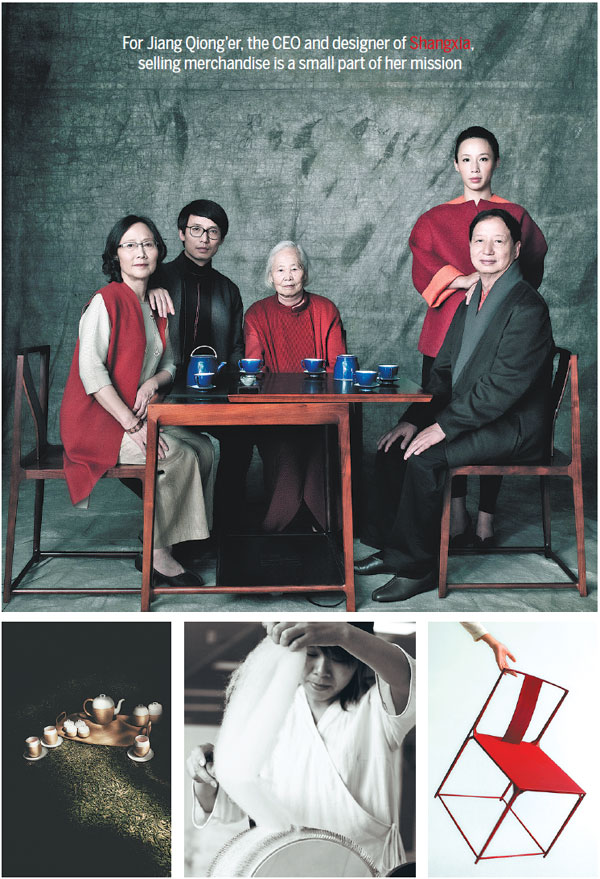Spreading culture with fashion and design
For Jiang Qiong'er, the CEO and designer of Shangxia, selling merchandise is a small part of her mission
A fashion model usually is young and has a perfect body, but Jiang Qiong'er, CEO and designer of Chinese brand Shangxia says her favorite model is her 96-year-old grandmother.
Her grandmother has been her model since she launched Shangxia in 2009 in Shanghai. Through the lenses of French photographer Paolo Roversi, the old woman with white hair and wrinkles on her face, looks beautiful and elegant.
"Shangxia is about time and emotion. My grandmother is a great model to showcase this," Jiang said at the Global Fashion Forum organized by Women's Wear Daily (WWD) recently in Beijing.
|
Clockwise from top: Jiang Qiong'er (standing) with her family; carbon fiber chairs made without nails; the making of a cashmere felt; a tea set with pot and tea cups made of bamboo and eggshell porcelain. Photos Provided to China Daily |
WWD, the world's leading journal of news and trends in fashion, beauty and retail, hosted the forum to bring together a global community of retail and brand executives and designers to explore the economic, consumer and design forces that are shaping the future of fashion in China.
Jiang, 40, with her brand Shangxia, which was cofounded with French luxury brand Hermes, is an example of how fashion is evolving on the mainland.
Jiang is the third generation of a Chinese artist's family in Shanghai.
Her grandfather Jiang Xuanyi (1903-1977) was one of the pioneer Chinese artists who studied Western art abroad, while her architect father Xing Tonghe, 76, worked on the Shanghai Museum, the renovation of The Bund and the Deng Xiaoping Memorial Hall in Sichuan.
"I do not take up architecture because my father's shadow is too huge," the designer says.
Jiang took up the brush pen to learn Chinese calligraphy and ink painting at 6. However, her formal design training started at Tongji University, Shanghai and after graduation in 2000, she furthered her studies in furniture and interior design at the Ecole des Arts Decoratifs in Paris.
In 2006, Hermes commissioned her to design windows for its boutique in Shanghai, and she so impressed the then CEO Patrick Thomas and artistic director Pierre-Alexis Dumas that they invited her to a business dinner.
There, the Chinese designer found that they shared the same values, passion and commitment to quality, craftsmanship, culture and style.
"They were looking for creativity and style but to keep the values of Hermes. And I had always dreamed of transporting Chinese traditional craftsmanship and aesthetics into a modern lifestyle and sharing it with people from the rest of the world," she says.
Thus Shangxia was born, and it now sells furniture, ready-to-wear, home decorations, accessories and leather goods.
"Shangxia" in Chinese means "ups and downs", but Jiang interprets "shang" as into the sky, the passage of history, craftsmanship, tradition, while "xia", she says is about the earth, the future, high technology and new materials.
"'Shangxia' represents Chinese philosophy - a balance or harmony between two opposites which we need," she says.
She hopes people who visit her boutique can experience sight, smell, touch, taste and hearing in a unique way.
The boutique does not look very Chinese as its postmodern white roof looks like endless clouds. The stones from Taihu Lake, close to Shanghai, remind you of a Chinese garden and break up the store into different spaces.
When the Japanese designer Kengo Kuma designed the boutique, Jiang told him that she did not want any obvious Chinese elements such as red lanterns and carved wood columns.
"Let's keep the Chinese aesthetic without using existing shapes and patterns. And let us make it 'one step, one view', which is a typical Chinese garden philosophy," she says she told the designer.
Inside the boutique you can smell tea. There is a tea house and customers can enjoy rest and meditation there.
The boutique also features music created by Chinese singer/songwriter DouWei, which is played on eggshell porcelain.
All the products at the boutique are made of natural materials - bamboo, silk, leather, carbon, porcelain and wood.
Speaking about the products, Jiang says: "China has a very rich heritage of craftsmanship. But most of the heritage is now consigned to museums, books and history. Our mission is to use this heritage and transform it into products for modern life.
"So every day we focus on three things: How can we make it (the heritage) functional? The second is how to make it fashionable, trendy, young and cool. And, how can we give emotional value to it?"
Giving one example of her bestselling products, Jiang points to carbon-fiber chairs made without nails, inspired by the Ming Dynasty (1368-1644).
The diameter of each leg is just 7-8 mm, and you can carry the chair with one finger.
"Our innovation was to use a new material, carbon fiber," she says.
Bamboo used to represent the spirit of Chinese culture, and Jiang once visited a craftsman in southwest China's Sichuan province where she saw him using 0.35 mm bamboo to weave an "elephant".
"It (the elephant) was for decoration. But why don't we use his craftsmanship to make something functional?" she says.
Later, she designed a tea set with pot and tea cups made of bamboo and eggshell porcelain.
She also designed a coat and scarf made using Mongolian cashmere.
"Mongolian cashmere has memory. When you have it, you want to keep it because it remembers the shape of your shoulders," she says.
In 2011, Shangxia staff interviewed 1,000 Chinese families, and used their photos, letters, telegrams and diaries to produce a book.
She also held an exhibition to display some of the photos in the boutique.
In Jiang's mind, Shangxia is not only about selling products.
What she wants to do is to share and pass on Chinese culture and lifestyle.
chenjie@chinadaily.com.cn



















